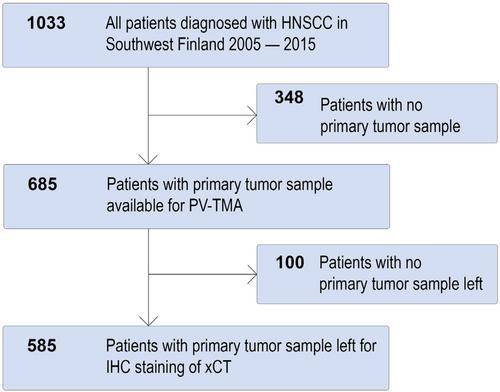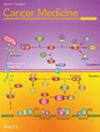xCT as a Predictor for Survival in a Population-Based Cohort of Head and Neck Squamous Cell Carcinoma
Abstract
Background
xCT, also known as SLC7A11 (solute carrier Family 7 Member 11), is a cystine/glutamate antiporter protein that mediates regulated cell death and antioxidant defense. The aim of this study was to investigate the effect of xCT on the outcome of patients diagnosed with new head and neck squamous cell carcinoma (HNSCC).
Methods
This retrospective cohort study utilized a population-based dataset, comprising all patients (n = 1033) diagnosed with new HNSCC during 2005–2015 in a population of 697,000 people. All patients (n = 585) with a tumor tissue sample available for immunohistochemical (IHC) staining were included. The follow-up rates were 97% and 81% at 3 and 5 years, respectively. Also, the specificity of the anti-xCT antibody was validated.
Results
The expression level and prognostic significance of xCT were strongly dependent on tumor location. In oropharyngeal squamous cell carcinoma (OPSCC) patients, xCT expression was a significant prognostic factor for 5-year overall survival (OAS) (HR: 2.71; 95% CI 1.67–4.39; p < 0.001), disease-specific survival (DSS) (HR: 2.58; 95% CI 1.47–4.54; p = 0.001), and disease-free survival (DFS) (HR: 2.69; 95% CI 1.55–4.64; p < 0.001). Five-year survival rates for OPSCC patients with high and low levels of xCT were OAS 34% versus 62%; DSS 51% versus 73%; DFS 43% versus 73%, respectively. According to a multivariate model adjusted for age, T-class, nodal positivity, and tobacco consumption, xCT was an independent prognostic factor for 3-year survival, in which it outperformed p16 IHC. Similar associations were not observed in squamous cell carcinomas of oral cavity or larynx. Regarding treatment modalities, xCT was most predictive in HNSCC patients who received radiotherapy.
Conclusions
High xCT expression was associated with poor prognosis in OPSCC. Our findings suggest that joint analysis of xCT and p16 may add significant value in OPSCC treatment stratification.


 求助内容:
求助内容: 应助结果提醒方式:
应助结果提醒方式:


